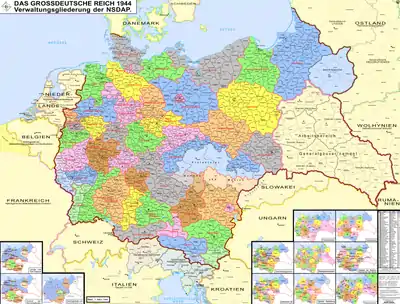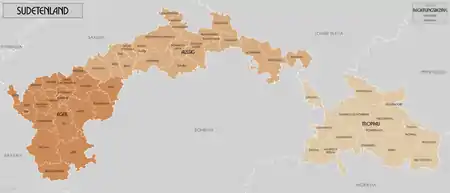Reichsgau Sudetenland
The Reichsgau Sudetenland was an administrative division of Nazi Germany from 1939 to 1945. It comprised the northern part of the Sudetenland territory, which was annexed from Czechoslovakia according to the 30 September 1938 Munich Agreement. The Reichsgau was headed by the former Sudeten German Party leader, now Nazi Party functionary Konrad Henlein as Gauleiter and Reichsstatthalter.[1] From October 1938 to May 1939, it was the regional subdivision of the Nazi Party in that area, also under Henlein's leadership. The administrative capital was Reichenberg (Liberec).
| Reichsgau Sudetenland | |||||||||
|---|---|---|---|---|---|---|---|---|---|
| Gau of Nazi Germany | |||||||||
| 1939–1945 | |||||||||
.svg.png.webp) Flag
 Coat of arms
| |||||||||
 Map of Nazi Germany showing its administrative subdivisions (Gaue and Reichsgaue) | |||||||||
| Capital | Reichenberg | ||||||||
| Government | |||||||||
| Gauleiter | |||||||||
• 1938–1945 | Konrad Henlein | ||||||||
| History | |||||||||
| 30 September 1938 | |||||||||
• Reichsgau established | 1 May 1939 | ||||||||
| 8 May 1945 | |||||||||
| |||||||||
| Today part of | |||||||||
History
In the course of the German occupation of Czechoslovakia, on 30 September 1938 the Heads of Government of the United Kingdom, France, Italy, and Germany signed the Munich Agreement, which enforced the cession of the Sudetenland to Germany. Czechoslovak representatives were not invited. On 1 October, invading Wehrmacht forces occupied the territory. The new Czechoslovak-German borders were officially fixed in a treaty on 21 November 1938. In consequence, the Czechoslovak Republic lost about one third of its population, its most important industrial area, and also its extended border fortifications.[2][3]
Initially, the German Army (Heer) established a civil administration under occupational law. On 30 October 1938, Konrad Henlein was appointed Gauleiter and Reichskommissar of Sudetenland.[4][5] The Sudeten German Party was merged into the Nazi Party, all other political parties were banned. The Czech population had to accept German citizenship or were expelled and forcibly relocated to the Czechoslovak rump state, which itself from 15 March 1939 was occupied by Germany and incorporated as the "Protectorate of Bohemia and Moravia".
After the proclamation of the Protectorate of Bohemia and Moravia, the Reichsgau was formally established by law on 25 March 1939, in effect from 15 April, borders were adjusted and the administrative structure was fixed on May 1. Konrad Henlein was named Reichsstatthalter.[6] The administrative capital was Reichenberg (Liberec). Smaller areas in the east, such as the Hlučín Region, were ceded to the Prussian Province of Silesia, while the western and southern Sudetenland territories were attached to the Bavarian Gau Bayreuth as well as to the Austrian Reichsgaue Oberdonau and Niederdonau.
After Germany's defeat in World War II, the Czechoslovak state was re-established and the Sudeten German population was expelled.
The Theresienstadt concentration camp was located in the Protectorate of Bohemia and Moravia, near the border to the Reichsgau Sudetenland. It was designed to concentrate the Jewish population from the Protectorate and gradually move them to extermination camps and also held Western European and German Jews. While not an extermination camp itself the harsh and unhygienic conditions still resulted in the death of 33,000 of the 140,000 Jews brought to the camp while a further 88,000 were sent to extermination camps and only 19,000 survived.[7]
Gauleiter
- Konrad Henlein: 30 October 1938 to 8 May 1945
Administration

The Reichsgau Sudetenland was divided into three Regierungsbezirke. These were subdivided into 58 districts (Kreise), largely corresponding to the former Czechoslovak okresy:[8]
Urban districts
Rural districts
Regierungsbezirk Eger
President:
- 1939–1940: Wilhelm Sebekovsky
- 1940–1945: Karl Müller
Rural districts
Regierungsbezirk Troppau
President:
- 1939–1943: Friedrich Zippelius
- 1943–1945: Karl Ferdinand Edler von der Planitz
Urban districts
See also
- Gauliga Sudetenland, the highest association football league in the Gau from 1938 to 1945
- The Holocaust in the Sudetenland
References
- .Michael D. Miller and Andreas Schulz. Gauleiter: The Regional Leaders of the Nazi Party and Their Deputies, 1925-1945, Vol. 1. R. James Bender Publishing. p. 474. ISBN 1-932970-21-5.
- "Die NS-Gaue" [The Nazi Gaue]. dhm.de (in German). Deutsches Historisches Museum. Retrieved 24 March 2016.
- "Die Besetzung des Sudetengebietes 1938" [The occupation of the Sudetenland in 1938]. dhm.de (in German). Deutsches Historisches Museum. Retrieved 24 March 2016.
- "Henlein Named Leader", NY Times, 1 November 1938, page 16.
- "Übersicht der NSDAP-Gaue, der Gauleiter und der Stellvertretenden Gauleiter zwischen 1933 und 1945" [Overview of Nazi Gaue, the Gauleiter and assistant Gauleiter from 1933 to 1945]. zukunft-braucht-erinnerung.de (in German). Zukunft braucht Erinnerung. Retrieved 24 March 2016.
- .Michael D. Miller and Andreas Schulz. Gauleiter: The Regional Leaders of the Nazi Party and Their Deputies, 1925-1945, Vol. 1. R. James Bender Publishing. p. 474. ISBN 1-932970-21-5.
- "Theresienstadt" (PDF). yadvashem.org. Yad Vashem. Retrieved 13 April 2016.
- "Reichsgau Sudetenland". verwaltungsgeschichte.de (in German). Retrieved 24 March 2016.
Further reading
- Suppan, Arnold (2019). "The Reichsgau Sudetenland". Hitler–Beneš–Tito: National Conflicts, World Wars, Genocides, Expulsions, and Divided Remembrance in East-Central and Southeastern Europe, 1848–2018. Vienna: Austrian Academy of Sciences Press. pp. 475–484. ISBN 978-3-7001-8410-2. JSTOR j.ctvvh867x.